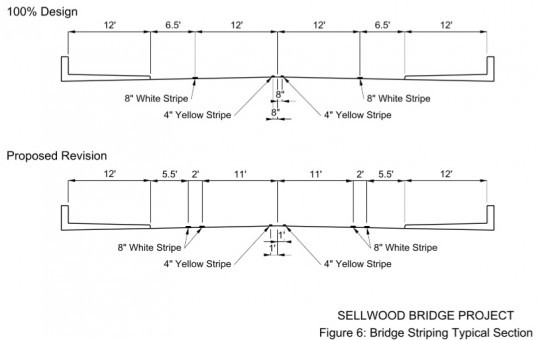
The final design of the bike lanes on the new Sellwood Bridge might not be what you expected. And that’s good or bad news depending on your perspective.
It turns out the bike lanes could be a different color and size than initially planned.
When the curtains came up for the big opening celebration two weeks ago many of you noticed something missing from the main deck of the bridge surface: green pavement to demarcate the bike lane from the adjacent standard lanes. The green colored bike lanes were part of the “final” plans adopted by Multnomah County in July of 2012. They were also still in the plans when we checked in on the project in October of last year.
The idea behind the green paint was to keep people from driving in the bike lane. “Our main goal is to indicate to drivers that the shoulder is a bike lane and that bicyclists have a right to be there,” Multnomah County spokesman Mike Pullen told us in 2012. The green pavement treatment is estimated to cost $81,000, a line item in the budget that was once on the chopping block only to be reinstated after concerns from bike advocates and former Mayor Sam Adams.
As the project nears completion the green paint might not make it into the plans after all — but there’s also a chance that the bike lane could get a buffer zone.
Advertisement
At the February meeting of the Multnomah County Bicycle and Pedestrian Citizen Advisory Committee, county staff proposed changes to the bridge cross section. According to draft minutes from the meeting, the county’s impetus for the changes was to “slow vehicle traffic.”
To encourage people to drive slowly, the county is considering narrowing the two standard vehicle lanes from 12-feet to 11-feet (they’d be 10-feet wide in the middle of the span and get larger toward the ends). They would also narrow the bike lane to 5.5 feet (down from 6.5 feet) and then add a 2-foot painted buffer zone between the bikeway and the other lanes.
As for the green paint, bridge construction crews haven’t found the right mix of materials and application method that meets their standards. The thermoplastic used in bike boxes isn’t feasible for this much space and the county has not been pleased with tests of a concrete stain. The stain they’ve tried wasn’t durable enough and it produced a darker shade of green than what the City of Portland uses.
The City of Portland has been successful with green color on large sections of SW Stark and Oak in downtown Portland. The difference with that application is that it’s on asphalt whereas the bridge is a concrete surface. The County is currently discussing the issue with the City.
Given the added cost and the results of testing so far, the members of the bike advisory committee told the County they “generally felt okay” not using the green on the entire bridge span. The green color will likely be used to indicate potential conflict areas at intersections on each end of the bridge — but the county said they’ll wait until all the intersections are built before deciding where to put it.
The final striping and coloring plan is still in development. The County’s bicyle and pedestrian advisory committee meets tonight to talk more about it. You can swing by and join the conversation at the Multnomah Building (501 SE Hawthorne Blvd) from 6:30 – 8:30pm.
Stay tuned.
— Jonathan Maus, (503) 706-8804 – jonathan@bikeportland.org
BikePortland can’t survive without paid subscribers. Please sign up today.

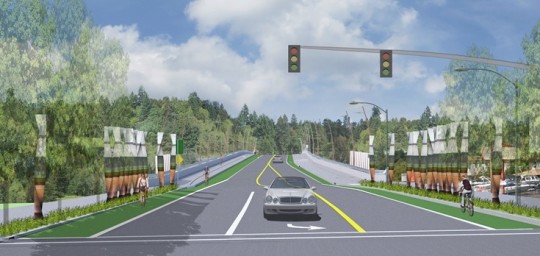
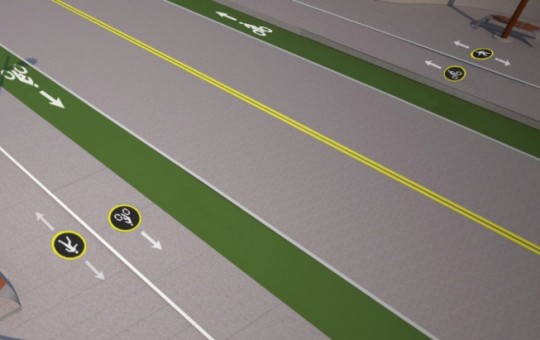
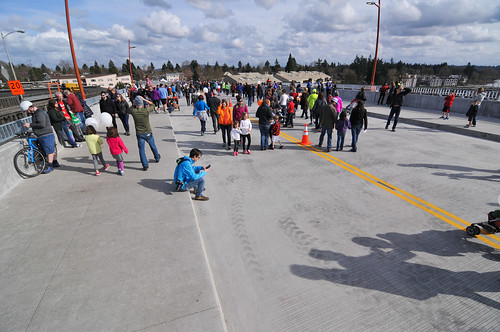
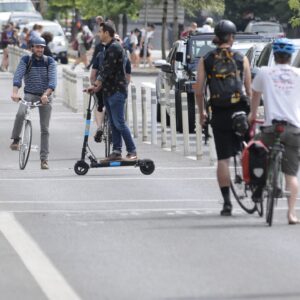
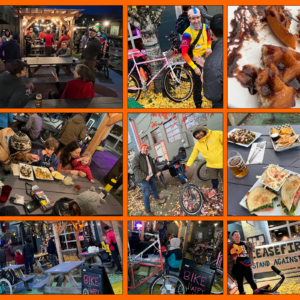
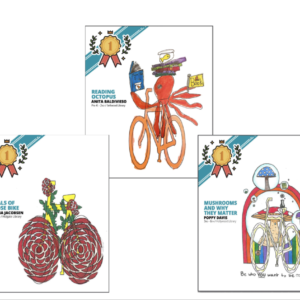
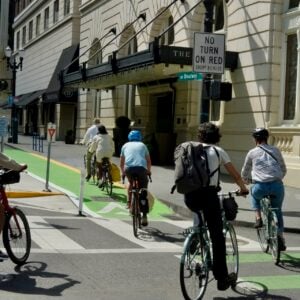
Thanks for reading.
BikePortland has served this community with independent community journalism since 2005. We rely on subscriptions from readers like you to survive. Your financial support is vital in keeping this valuable resource alive and well.
Please subscribe today to strengthen and expand our work.
The traffic light close to the bridge might lead to more cut-thru auto traffic on side streets.
Might? That was the preferred route for the last couple years as traffic flow is abhorrent. But Portland’s planning for cars is generally also ridiculous. Not everything can be done on a bike.
You’re right. We should have destroyed the business district along Tacoma and widened it to 4 lanes. We can’t have our friends from Clackamas sitting in traffic!
The neighborhood is very concerned about cut-through traffic, which is why it will be illegal to make a left turn from SE 6th Ave northbound onto the bridge. Currently, it can take a half hour to get from Oaks Park to the bridge on busy days. It’s hoped the light will help. The signal timing, and certain turn restrictions are intended to make sure that even when traffic on Tacoma is heavy, drivers realize they won’t save any time by trying to cut through the neighborhood. That’s a goal the neighbors will be keeping an eye on.
Bait and switch. The green on the Moody protected lanes seems to work just fine on concrete surfaces. Whats the problem?
Yeah. I wouldn’t have expected to see it in place already at the opening celebration two weeks ago because half of the east end is still missing, but where do they get off saying they don’t know how they’re going to do it when they already did it on Moody?
i think one of the problems is that we have three different agencies trying to build bikeways in isolation: Stark and Oak = PBOT, Moody = TriMet, Bridge = County.
would be sooo much better for all of us if we had one agency building our infrastrucure. absent that, we rely on them all talking to each and sharing best practices… and we know how that can go sometimes.
Notice how ODOT is conspicuously absent from that list.
ODOT builds bikeways as well. I’m not sure if they’ve used green paint/thermoplastic before. Anyone know?
Then you have Bend that went with red for it’s bikeways.
Is that a lead-in for a Deadpool reference?
Barbur has green paint, right?
http://bikeportland.org/2012/03/14/sw-barbur-blvd-will-get-odots-first-green-bike-lane-68881
Yeah, but there’s not much left.
They rebuilt part of the SW Iowa Street trail that connects Highway 43 to SW Terwilliger Blvd.
The white lines will be gone in 2 months. We need the little ripples that are used on a lot of the freeways on the side lanes. Kind of like rumble strips but smaller and more durable and white. They could also be made of green urathane.
I was at the county bike/ped meeting this evening. As far as I know, no one showed up to discuss the Sellwood Bridge bike lanes. The next meeting is scheduled for Wednesday, April 13 630-830p at the county building at 501 SE Hawthorne. All meetings are open to the public and there is a dedicated public comment period. Anyone with thoughts on this or any other county bike/ped issues is welcome to join the discussion.
I left multiple comments.
They drive in the buffer instead of the bike lane, but there are no curves here. 11ft is TOO WIDE for 25mph traffic, especially in a straight line with so much “recovery area”. 8.5 at most. Best method is to keep narrowing it until the bus runs a bit under the posted speed.
Did I understand that you desire an 8.5ft lane for auto/ truck travel ? You do know that a city bus is on avg, 8.75 ft wide?
Good thing they’re operated by professionals and only moving at 25mph in a straight line here!
11 feet is preferred width for lanes used by buses and trucks, and research has definitely shown a reduction in speeds when going from 12 to 11 feet. 10 feet is even better, but TriMet doesn’t like it because the buses are 10.5 feet wide if you include mirrors. 9.5 feet is basically the minimum lane width for a new facility. Some 9 foot lanes exist around town, but they cause some safety problems.
How about bright green or yellow truncated domes to separate the lanes? These are used downtown to separate vehicles form MAX routes- pretty effective but still allows access by emergency vehicles. Put a big rectabngle of green thermoplastic at the foot of the bridge, and place the domes every 10′ along the length.
Ditch the bike lanes entirely. Paint chevron markings in them, striping them as what they really are: emergency breakdown lanes. Since this is a two-lane bridge, LOS mandate dictates there be a emergency pull-off lane so broken down cars don’t block traffic. I disagree with this mandate, but it’s there nonetheless. Likely, Multnomah County assumed that if they were required to stripe breakdown lanes, that they might as well stripe them as bike lanes too. I’m sure they were well-intentioned. However, a painted bike lane is never going to be as safe as the shared sidewalk, so why are we encouraging people to use the painted lanes when the sidewalk is right next door? Don’t lure people into an unsafe, substandard facility. Add the bike stencils to the shared sidewalk and encourage people cycling to use it, rather than the roadway.
Adam: If you don’t feel safe riding in a bike lane next to auto traffic, just don’t do it. If you want to ride in the lane adjacent to the pedestrians by all means choose that.
I’m pleased as punch that I have a choice!
I expect to use the lane next to the autos when I’m riding fast and have places to go. I expect to use the section adjacent to the pedestrians when I’m riding with my kids or out-of-town visitors when we might want to stop to see the view.
Under most circumstances, I’m more fearful of having meandering pedestrians step in front of me than I am of having a car run me down from behind. I’ve had lots more close calls with pedestrians and unskilled cyclists when I’ve been on a MUP than I’ve had from motorists when I’ve been in a full-width standard bike lane.
Please stop trying to redesignate the on-street bike lane as a breakdown lane. If you don’t want to use it, just avoid it. Don’t prevent those of us who want to from doing so.
By the way, I was one of the many cyclists who participated in the public meetings conducted during the design phase who testified in favor of what’s planned.
I notice that even you referred to it as a sidewalk, a very self-explanatory term.
Please stop trying to remove my vehicle status.
Unsafe bike lane to you is fast and comfortable to me.
Cyclists should have choices. Not all cyclists feel the need to ride behind concrete barriers. Not all cyclists want to dodge pedestrians and soft pedal behind slower riders.
The bike lane will be fine. Would have been better with green stain but a buffer line with be okay too. If you don’t like it, ride on the raised path.
There will be lots of times when the sidewalk will be crowded with pedestrians–groups, families, kids, dogs–plus slow bikes. Adding cyclists who want to go fast into that mix is less safe for those cyclists and for the pedestrians meandering in front of them, than giving fast cyclists the option of riding off the sidewalk. The sidewalk isn’t wide enough for pedestrians plus slow cyclists plus fast ones.
This is only a problem because the county designed the bike facility as a shared sidewalk instead of a cycle track. So we are left to make the most out of their poor design choices. Had the bridge been designed with wide cycle tracks instead of a shared sidewalk and a bike lane, there would have been enough room for slow and fast riders.
We should also not be designing bike facilities for people riding road bikes who want to ride fast. Those people are willing to ride anywhere, and make up a very small percentage of potential riders. To really make a dent in the SOV mode share, we need to make all of our bike facilities appealing to the “interested but concerned” group and for families. Painted bike lanes and “greenways” without diversion aren’t going to cut it.
I agree with some of that–for the next project. But this one’s “sidewalk” is too narrow to accommodate everyone, so encouraging all bikes to mix with pedestrians is a bad idea.
Also, while it’s certainly important in general to make bike facilities appeal to the non-speedy, it IS important for this bridge to give fast bikes a choice other than to mix with kids, dogs and slow bikes on the one hand, or cars on the other.
Mixing them in with the sidewalk traffic is dangerous because even moderately-fast bikes will be going much faster than other users (who are wandering around not expecting fast quiet bikes to come up behind them). And a lot of cyclists who go too fast (and that doesn’t mean road-bike racing speed) to mix with the 2 mph sightseers on the sidewalk would not feel comfortable or safe in the same lane with cars, especially since half the bridge each way is uphill, few could keep up with traffic, and there’s not a second lane to allow cars to pass them.
Yes, the space marked for bike lanes can be used for emergencies, either a breakdown or so emergency vehicles can get passed a traffic jam. But a big benefit for people who ride or walk is that there will be choices and separation. Instead of cramming fast and slow riders together with pedestrians, people who want to power on across the bridge will have a lane on the road surface. Those who want to take a leisurely ride and enjoy the view can use the wide sidewalks. Even now it is already a pleasure to ride across. I’m really looking forward to the final layout this fall. Then the big issue facing people riding across the bridge will be the entirely inadequate trail on the west side of the river. Something to work on.
Heading north from the Sellwood Bridge on the west side looks like this: if you don’t like the narrow, bumpy, oft-flooded, trail that is littered with blind corners and saddled with a 10 mph bike speed limit, then your other choices are Macadam’s sidewalks or the neighborhood streets that parallel Macadam. The neighborhood streets would be fine if they weren’t driven on by the most aggro and/or clueless cut-through drivers in the city.
I recently moved from Johns Landing to Milwaukie and commute to the South Waterfront. I will *never* take the Sellwood bridge on my commute. Much better to go a mile and a half out of my way to stay on the Springwater and cross the river at the Tilikum than to deal with that mess.
I’m fine with buffer lanes as long as they don’t put the (whatever they call those) raised bumps on the inside line of the buffer the way they did on the North Denver project.
No one on a bicycle needs a physical alert that they are about to unintentionally stray into the motor vehicle lane because they’re futzing with their phone/makeup/cheeseburger.
We will know that we have finally saved the planet and our civilization from the pollution, climate change, suburban sprawl and carnage that is the automobile when the decision becomes, not what color to paint the bike lane on the bridge, but what color to make the lane that the few remaining dead-enders will drive their fossil fuel jalopies on. Perhaps yellowish brown like smog would be a fitting color.
I like that the travel lanes are a little narrower and the bike lane buffer even if it is just pain, might help slow traffic as a visual. Green paint seems a waste on the bridge, it should be reserved for conflict points or else it will lose its ability to grab drivers’ attention.
“Our main goal is to indicate to drivers that the shoulder is a bike lane and that bicyclists have a right to be there…”
Sigh. Yes, but what we need is a place where drivers don’t have a right to be. I know, I know – too late for this bridge. But this timid, don’t-bother-the-nice-drivers approach is getting old.
I have a serious problem with a transportation dept using the terms shoulder and bike lane interchangeably.
A shoulder is not a travel lane. That’s likely what they’ve been getting at with the paint and striping changes. It really is a shoulder in their minds and they are going to treat it as such.
ODOT doesn’t make bike lanes. We get shoulders that vary from 2″ to 6ft. Sometimes they stick a bike symbol in it, but I assure you, these are just shoulders in their mind.
The narrower lanes will be a safer design, I’m OK as well with the buffer. The bike lanes in the breakdown, pull over for emergency vehicle lanes, Will be wide enough for passing by fast commuter cyclists, plus give lots of buffer distance. The 12 wide sidewalk is bike accessible as well and being two feet wider than the Hawthorne this bridge will have more bike capacity than any other crossing in the city, Tilikum included.
Has anyone thought of just a simple bike lane each way? That’s all I have wanted commuting each way for more than 13 years.
Without a painted line some drivers pull over to the right of the lane, up against the curb. and this happens all of the way down Tacoma heading West.
Not good enough for the BikePortland crowd, sorry…
🙁
If they have two feet to make a buffer with then they could put in a concrete one foot wide curb. They could make it low and mountable by having a slope on it. It could still be used for a car that broke down.
For anyone driving normally they’ll sense when they rub against it that they should not veer over into the bike lane/breakdown lane.
There should also be a few ramps up to the sidewalk so that when you encounter a broken down car you can cycle up to the shared sidepath to get around it.
We need some sort of “humpty-bumps” in the buffer, something that would keep cars out of that space but that would still let it be used as a breakdown lane (since that’s apparently mandated).
TriMet bus # 99 won’t even offer local service for Sellwood and South Portland once the new bridge is finished. A TriMet bus doesn’t need 12 feet.
I hate the idea of narrowing the bike lanes for the buffers. The buffers create a no-man’s land for no good reason. Just do seven and one-half foot bike lanes. Motorists still wouldn’t be allowed in the bike lane and those cyclists who prefer more space from the autos can hug the curb just fine.
Of course then we don’t get to check off “buffered bike lane” on the LAB list. We would get to check off “two meter plus bike lane” if Lab had such a category.
If you stripe a 7.5ft bike lane with no buffer, people are going to drive in it. Guaranteed.
And people are going to ride outside to bike lane.
For $340 million we get this?